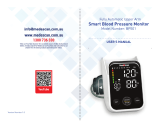
Contents
Thank you for purchasing the OMRON
®
BP760N Blood Pressure Monitor.
Your new blood pressure monitor uses the oscillometric method of blood pressure
measurement. This means the monitor detects your blood movement through your brachial
artery and converts the movements into a digital reading. An oscillometric monitor does not
need a stethoscope so the monitor is simple to use.
Intended Use
This device is a digital monitor intended for use in measuring blood pressure and pulse rate in
adult patient population who can understand this instruction manual with the arm
circumference range printed on the arm cuff. The device detects the appearance of irregular
heartbeats during measurement and gives a warning signal with the measurement result.
Important Safety Information........................1
1. Know Your Device....................................4
1.1 Display Symbols.....................................5
1.2 Before Taking a Measurement...............6
2. Preparation ...............................................7
2.1 Battery Installation..................................7
2.2 Setting the Date and Time .....................8
3. Using the Device ......................................9
3.1 Applying the Arm Cuff ............................9
3.2 How to Sit Correctly .............................10
3.3 Taking a Measurement ........................11
3.4 Using the Memory Function .................14
4. Error Messages and Troubleshooting..17
4.1 Error Messages ................................... 17
4.2 Troubleshooting................................... 19
5. Maintenance and Storage......................20
5.1 Maintenance ........................................ 20
5.2 Storage ................................................ 21
5.3 Optional Medical Accessories ............. 22
6. Specifications.........................................24
7. FCC Statement........................................25
8. Limited Warranty....................................26
9.
Guidance and Manufacturer’s Declaration.. 27
Please read this instruction manual thoroughly before using the device.
Please keep for future reference. For specific information about your own
blood pressure, CONSULT YOUR PHYSICIAN.



























